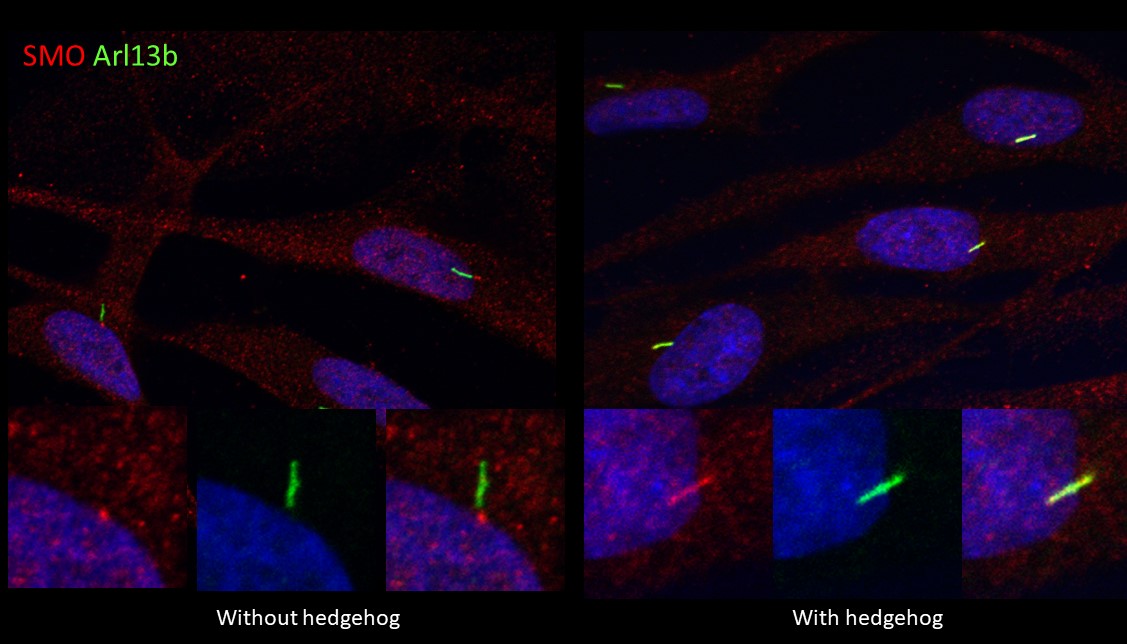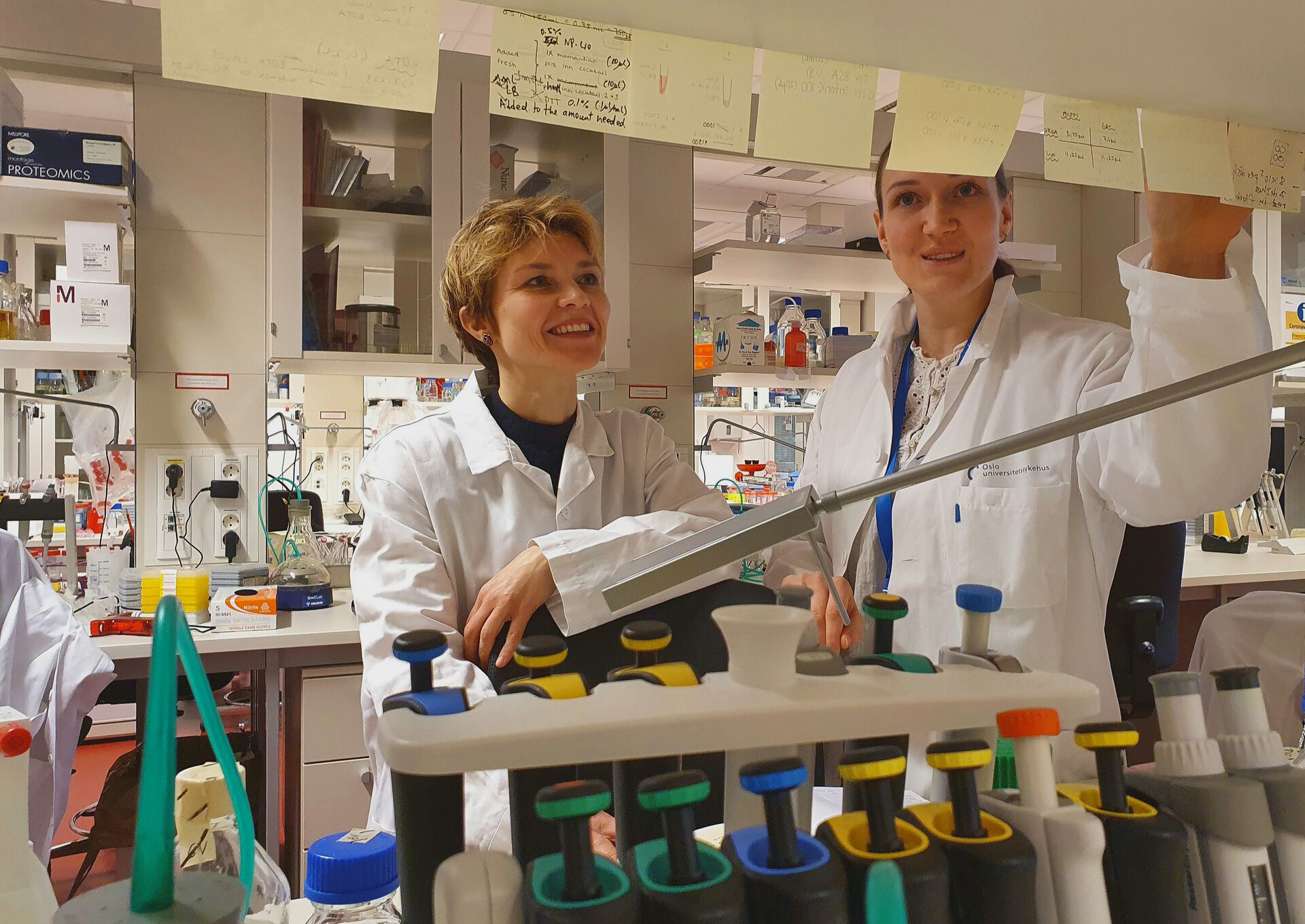Tekna is a labor union with over 80 000 members, and you can read more about it at their Web page. Earlier this year they announced their call for a grant to a master’s thesis that has the potential to be extraordinary. It is with great joy that we can announce that CanCell Master student Riccarda (Ricci) Schimanski was awarded a grant of 25.000 NOK. Ricci is a Master student at the Department of Biosciences at the University of Oslo, supervised by Viola Lobert in Tor Erik Rusten’s group. They work at the Institute for Cancer Research.
Firstly, congratulations with the grant Ricci! How are you feeling?
– I feel good and excited!
Ricci tells us via Zoom. She is currently working on her master’s thesis and investigates novel regulators of hedgehog signaling in the primary cilium. The initial plan for her thesis was to use mouse and human cell lines grown in the lab, but the grant extends the study further in vivo. We are eager to hear more and asked Viola Lobert to tell us about the project.
– The major interest of this mini team consisting of Ricci and me is the role of tumor suppressors in different cellular processes important for development and cancer, including ciliogenesis, says Viola.
A huge new opportunity
The Tekna grant enables Ricci to add another dimension to her project. She plans to use the money to travel to a laboratory in Umeå, Sweden, to look at hedgehog signaling in fruit flies. The lab belongs to Mattias Alenius who works with olfactory and taste systems in fruit flies. You can read more about his projects and lab here, link to his lab.
In vertebrates, hedgehog signaling only happens in little antennas called cilia, but in invertebrates like the fly it can occur at the plasma membrane without any cilium, Viola tells us.
– A fascinating aspect is that certain tumors in fact manage to activate hedgehog signaling without cilia, like what happens in flies.
So where do the fruit flies of Mattias Alenius come into the picture? It turns out that his lab identified the presence of cilia in the fruit flies’ olfactory sensory neurons (Kuzhandaivel et al., 2014).
Another fun aspect, she tells us about, is that one of the co-authors of this influential paper is CanCell member Sebastian Schultz, who spent some time in the Alenius lab after finishing his PhD. Mattias Alenius has described in several subsequent papers that the inability of these neurons to send signals using the hedgehog pathway affects their behavior.

Note, Human fibroblasts were either left untreated (left) or treated with hedgehog (right). Hedgehog treatment induces the translocation of Smoothened (SMO, red) into the axoneme of the cilium, labeled with anti-Arl13b (green). Importantly, these proteins are conserved in Drosophila melanogaster.
There is no doubt that Matthias has done some ground-breaking work and that it is a great opportunity for Ricci to be able to travel to his lab. We want to conduct experiments in the Alenius lab that will hopefully shed light on whether the phenotype that we observe in the human cells is dependent on the cilium or not, Viola explains.
Disoriented flies might shed light on hedgehog signaling in cancer
As mentioned earlier, fruit flies have cilia-dependent and -independent hedgehog signaling. In many cancer cells the pathway is aberrantly turned on, promoting tumorigenesis. Studying cilia -dependent and -independent hedgehog signaling is therefore an important approach when studying cancer, and Drosophila seems to be a great model for this. But this is not all; cilia are crucial for many functions of the body and their absence or dysfunction can have severe consequences; Viola says.
In some rare cases you can see patients that have their hearts positioned on the right side instead of the left side, a condition known as situs inversus, she continues.
She also tells us that even though this is perhaps surprising, it is not the most severe result of problems with cilia.
In fact, a whole category of diseases known as ciliopathies encompasses several disorders for which the cause is defective structure and function of cilia. Examples include renal cystic disease, polydactyly, genital defects and retinal degeneration. But what kind of results can they expect to have in the flies?
– If the flies are unable to respond to certain odors because of interfering with our tumor suppressors of interest, this will suggest that our preliminary results observed in cell lines are true in vivo, and are important in regulating hedgehog signaling in the cilia of the sensory neurons, Ricci says.
This grant is going to cover aspects of this that we can’t do in Oslo. It is an additional part of this project that is going to be fun and will allow Ricci to study whether our in vitro observations affect the physiology of the flies and their behavior, Viola points out.
Be fearless
It is no secret that the ongoing pandemic impacts science in many ways. Ricci tells us about the insecurity that the pandemic brought with it. Viola adds that this grant is a huge opportunity for Ricci since there are very few grants that are awarded to master’s students.
– What I have learnt during my studies and by watching others here at the institute is that you must be proactive, Ricci.
Opportunities are not just waiting for you; the competition is just too fierce. Being proactive requires you to be fearless, and that is not always easy. I thought this application was a long shot, but I am very grateful that Tekna wants to support students in the medical sciences as well, Ricci concludes.

References
Kuzhandaivel A, Schultz SW, Alkhori L, Alenius M. Cilia-mediated hedgehog signaling in Drosophila. Cell Rep. 2014 May 8, doi: 10.1016/j.celrep.2014.03.052, PMID: 24768000. Link to article.
Links:
- Into the fish lab, video tour of the fish lab.
- TEKNA web page
- The lab of Mattias Alenius
- Cilia-mediated hedgehog signaling in Drosophila (Article).
